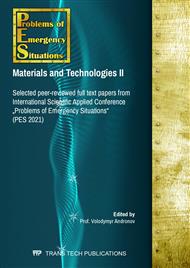[1]
A. Vasenko, O. Rybalova, O. Kozlovskaya, A study of significant factors affecting the quality of water in the Oskil River (Ukraine). Eastern-European Journal of Enterprise Technologies, 3(10–81) (2016) 48–55.
DOI: 10.15587/1729-4061.2016.72415
Google Scholar
[2]
João A. Freire, Gonçalo C. Rodrigues, Margarida Tomé, Climate Change Impacts on Pinus pinea L. Silvicultural System for Cone Production and Ways to Contour Those Impacts: A Review Complemented with Data from Permanent Plots. Forests, 10(2), (2019) 169.
DOI: 10.3390/f10020169
Google Scholar
[3]
Maria Margarida Ribeiro, Nata´lia Roque, Sı´lvia Ribeiro, Catarina Gavinhos, Isabel Castanheira, Luı´s Quinta-Nova, Teresa Albuquerque, Saki Gerassis, Bioclimatic modeling in the Last Glacial Maximum, Mid-Holocene and facing future climatic changes in the strawberry tree (Arbutus unedo L.). PloS ONE, 14(1) (2019) 0210062.
DOI: 10.1371/journal.pone.0210062
Google Scholar
[4]
O. Rybalova, S. Artemiev, M. Sarapina, B. Tsymbal, A. Bakhareva, O. Shestopalov, O. Filenko, Development of methods for estimating the environmental risk of degradation of the surface water state. Eastern-European Journal of Enterprise Technologies. 2(10–92) (2018) 4–17.
DOI: 10.15587/1729-4061.2018.127829
Google Scholar
[5]
O. Rybalova, S. Artemiev, Development of a procedure for assessing the environmental risk of the surface water status deterioration. Eastern-European Journal of Enterprise Technologies. 5(10–89) (2017) 67–76.
DOI: 10.15587/1729-4061.2017.112211
Google Scholar
[6]
O. Kovaliova, O. Pivovarov, V. Kalyna, Yu. Tchoursinov, E. Kunitsia, A. Chernukha, D. Polkovnychenko, N. Grigorenko, T. Kurska, O. Yermakova, Implmentation of the plasmochemical activation of technological solutions in the process of ecologization of malt production. Eastern-European Journal of Enterprise Technologies. 5/10 (107) (2020) 26–34.
DOI: 10.15587/1729-4061.2020.215160
Google Scholar
[7]
V. Loboichenko, T. Tishakova, A. Vasyukov, Application of direct coulometry for rapid assessment of water quality in Krasno-Oskol Reservoir (Kharkiv Region, Ukraine). Der Pharma Chemica. 8(19) (2016) 27-34.
Google Scholar
[8]
V. Bezsonnyi, O. Tretyakov, B. Khalmuradov, R. Ponomarenko, Examining the dynamics and modeling of oxygen regime of chervonooskil water reservoir. Eastern-European Journal of Enterprise Technologies. 5(10–89) (2017) 32–38.
DOI: 10.15587/1729-4061.2017.109477
Google Scholar
[9]
I. Dadashov, V. Loboichenko, A. Kireev, Analysis of the ecological characteristics of environment friendly fire fighting chemicals used in extinguishing oil products. Pollution Research. 37(1) (2018) 63–77.
Google Scholar
[10]
V. Loboichenko, N. Leonova, V. Strelets, A. Morozov, R. Shevchenko, P. Kovalov, R. Ponomarenko, T. Kovalova, Comparative analysis of the influence of various dry powder fire extinguishing compositions on the aquatic environment. Water and Energy International. 62(7) (2019) 63-68.
DOI: 10.36478/jeasci.2019.5925.5941
Google Scholar
[11]
V. Loboichenko, V. Strelets, N. Leonova, A. Malko, O. Іlyinskiy, Comparative analysis of anthropogenic impact on surface waters in Kharkiv region. Indian Journal of Environmental Protection. 40(2) (2020) 134–139.
Google Scholar
[12]
V. Loboichenko, V. Strelec, The natural waters and aqueous solutions express-identification as element of determination of possible emergency situation. Water and Energy International. 61(9) (2018) 43-50.
Google Scholar
[13]
Generation of waste by waste category, hazardousness and NACE Rev. 2 activity[env_wasgen] Information on http://www. Eurostat. europa.eu.
Google Scholar
[14]
Derzhavna sluzhba statystyky Ukrainy. Information on http://www. ukrstat.gov.ua.
Google Scholar
[15]
Alessia Cavaliere, Silvia Pigliafreddo, Elisa De Marchi, Alessandro Banterle. Do Consumers Really Want to Reduce Plastic Usage? Exploring the Determinants of Plastic Avoidance in Food-Related Consumption Decisions. Sustainability (2020-11-01). (2020) 9627.
DOI: 10.3390/su12229627
Google Scholar
[16]
European Commission (2017). Information on http://ec.europa.eu/ environment/waste/index.htm.
Google Scholar
[17]
Recycling Remains a Rarity in Eastern Europe. OneEurope. Information on http://one-europe.net/eurographics/ recycling-remains-a-rarity-in-eastern-europe.
Google Scholar
[18]
Carina Hartmann, Irena Žmak. Current state of the plastic waste recycling system in the European Union and in Germany. TEHNIČKI GLASNIK (JAN 2017). 11(3) (2017) 138 – 142.
Google Scholar
[19]
Sevenster. Use of plastics. Information on http://www.plasticseurope.org/use-of-plastics/buildingconstruction.aspx.
Google Scholar
[20]
Villafañe Irene, Keogh Colin, Curran Thomas P., Reynaud Emmanuel G. Assessment of the Mechanical Properties of Pet Polymer Material from Recovered Plastic Bottles. Present Environment and Sustainable Development (2018 -06-01). 12(1) (2018) 203 – 214.
DOI: 10.2478/pesd-2018-0016
Google Scholar
[21]
Vittorio Silano, José Manuel Barat Baviera, Claudia Bolognesi, Andrew Chesson, Pier Sandro Cocconcelli, Riccardo Crebelli, David Michael Gott, Konrad Grob, Evgenia Lampi, Alicja Mortensen, Gilles Rivière, Inger-Lise Steffensen, Christina Tlustos, Henk Van Loveren, Laurence Vernis, Holger Zorn, Safety assessment of the process PETman, based on Starlinger Decon technology, used to recycle post-consumer PET into food contact materials. EFSA Journal (2019-10-01), 17 (2019) 10:5829.
DOI: 10.2903/j.efsa.2019.5829
Google Scholar
[22]
Nasrul Arahman, Afrillia Fahrina, Sastika Amalia, Rahmat Sunarya, Sri Mulyat (2017). Effect of PVP on the characteristic of modified membranes made from waste PET bottles for humic acid removal. F1000RESEARCH (JUN 2017).
DOI: 10.12688/f1000research.11501.2
Google Scholar
[23]
Jan Hakeem, Aman Mohamad Yusri, Khan Sheraz, Karim Fazal, Performance of Hot Asphalt Mixtures Containing Plastic Bottles as Additive. MATEC Web of Conferences. 103 (2017) 09006.
DOI: 10.1051/matecconf/201710309006
Google Scholar
[24]
Abed Adil, Al-Hadithi Abdulkader, Mohammed Ahmed Salih. The effects of adding waste plastic fibers on some properties of roller compacted concrete. MATEC Web of Conferences, 162 (2018) 02008.
DOI: 10.1051/matecconf/201816202008
Google Scholar
[25]
Wesam Salah Alaloul, Vivekka Olivia John, Muhammad Ali Musarat. Mechanical and Thermal Properties of Interlocking Bricks Utilizing Wasted Polyethylene Terephthalate. International Journal of Concrete Structures and Materials 14(1) (2020) 1–11.
DOI: 10.1186/s40069-020-00399-9
Google Scholar
[26]
DSTU 8691: 2016. Stichni vody. Nastanovy shchodo vstanovlennia tekhnolohichnykh normatyviv vidvedennia doshchovykh stichnykh vod u vodni obyekty. Nakaz vid 31.10.2016. № 356. Kyiv: UkrNDNTs, (2016).
Google Scholar
[27]
DSTU 3013-95. Hidrosfera. Pravyla kontrolyu za vidvedennyam doshchovykh i snihovykh stichnykh vod z terytorii mist i promyslovykh pidpryiemstv.
Google Scholar
[28]
Derzhavni sanitarni pravyla planuvannia ta zabudovy naselenykh punktiv: nakaz Ministerstva okhorony zdorovya Ukrainy vid 19.06.1996 r. № 173 [in Ukranian].
Google Scholar
[29]
Anton Matsak, Kateryna Tsytlishvili, Olga Rybalova, Sergey Artemiev, Andrey Romin, Oleksandr Chynchyk. Method of agricultural sewage water purification at troughs and a biosorption bioreactor. Eastern European Journal of Enterprise Technologies, 5(10) (2018) 95.
DOI: 10.15587/1729-4061.2018.144138
Google Scholar
[30]
Anatolii Grytsenko, Olha Rybalova, Anton Matsak, Sergey Artemiev. Using of Production Wastes in Stormwater Drainage Purification. Problems of Emergency Situations: Materials and Technologies, Materials Science Forum. 1006 (2020) 194-201.
DOI: 10.4028/www.scientific.net/msf.1006.194
Google Scholar


